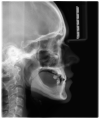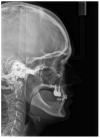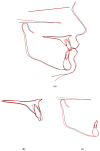Orthodontic Treatment of Palatally Impacted Canines in Severe Non-Syndromic Oligodontia with the Use of Mini-Implants: A Case Report
- PMID: 38004081
- PMCID: PMC10673481
- DOI: 10.3390/medicina59112032
Orthodontic Treatment of Palatally Impacted Canines in Severe Non-Syndromic Oligodontia with the Use of Mini-Implants: A Case Report
Abstract
Background: The risk of palatally displaced canines (PDCs) rises in patients with tooth agenesis. The orthodontic extrusion and alignment of PDCs require adequate anchorage to enable tooth movement and control the side effects. There is no paper presenting treatment in the case of severe oligodontia with simultaneous PDCs and the use of mini-implants (MIs) for their orthodontic extrusion. Case presentation: A 15-year-old patient presented with non-syndromic oligodontia and bilateral PDCs. Cone beam computed tomography revealed that both PDCs were in proximity to the upper incisors' roots. There was no evident external root resorption of the incisors. The "canines first" approach was chosen. MIs were used both as direct and indirect anchorage. First, the extrusive forces of cantilevers were directed both occlusally and distally. Next, the buccal directions of forces were implemented. Finally, fixed appliances were used. PDCs were extruded, aligned, and torqued. Proper alignment and occlusion were achieved to enable further prosthodontic restorations. Conclusions: The use of MIs made it possible to avoid collateral effects, reduce the risk of complications, and treat the patient effectively. MIs provide adequate anchorage in demanding cases. The use of MIs for the extrusion of PDCs made it possible to offer this treatment option to patients with severe oligodontia. The presented protocol was effective and served to circumvent treatment limitations associated with an inadequate amount of dental anchorage and a high risk of root resorption.
Keywords: cone beam computed tomography; impacted canine; oligodontia; temporary anchorage device; tooth impaction.
Conflict of interest statement
The authors declare no conflict of interest.
Figures
















Similar articles
-
Incisor root resorption associated with palatally displaced maxillary canines: Analysis and prediction using discriminant function analysis.Am J Orthod Dentofacial Orthop. 2020 Jan;157(1):80-90. doi: 10.1016/j.ajodo.2019.08.008. Am J Orthod Dentofacial Orthop. 2020. PMID: 31901286
-
Health of periodontal tissues and resorption status after orthodontic treatment of impacted maxillary canines.Niger J Clin Pract. 2018 Mar;21(3):301-305. doi: 10.4103/njcp.njcp_419_16. Niger J Clin Pract. 2018. PMID: 29519977
-
Apical root resorption of incisors after orthodontic treatment of impacted maxillary canines: a radiographic study.Am J Orthod Dentofacial Orthop. 2012 Apr;141(4):427-35. doi: 10.1016/j.ajodo.2011.10.022. Am J Orthod Dentofacial Orthop. 2012. PMID: 22464524
-
The impacted maxillary canine. Further observations on aetiology, radiographic localization, prevention/interception of impaction, and when to suspect impaction.Aust Dent J. 1996 Oct;41(5):310-6. doi: 10.1111/j.1834-7819.1996.tb03139.x. Aust Dent J. 1996. PMID: 8961604 Review.
-
Guidance for the Clinical Management of Impacted Maxillary Canines.Compend Contin Educ Dent. 2021 May;42(5):220-226; quiz 228. Compend Contin Educ Dent. 2021. PMID: 33980019 Review.
Cited by
-
Infraocclusion in the Primary and Permanent Dentition-A Narrative Review.Medicina (Kaunas). 2024 Mar 1;60(3):423. doi: 10.3390/medicina60030423. Medicina (Kaunas). 2024. PMID: 38541149 Free PMC article. Review.
-
Tooth Autotransplantation, Autogenous Dentin Graft, and Growth Factors Application: A Method for Preserving the Alveolar Ridge in Cases of Severe Infraocclusion-A Case Report and Literature Review.J Clin Med. 2024 Jul 3;13(13):3902. doi: 10.3390/jcm13133902. J Clin Med. 2024. PMID: 38999468 Free PMC article.
References
-
- Letra A., Chiquet B., Hansen-Kiss E., Menezes S., Hunter E. Nonsyndromic Tooth Agenesis Overview. In: Adam M.P., Everman D.B., Mirzaa G.M., Pagon R.A., Wallace S.E., Bean L.J., Gripp K.W., Amemiya A., editors. GeneReviews®. University of Washington; Seattle, WA, USA: 1993. - PubMed
Publication types
MeSH terms
LinkOut - more resources
Full Text Sources

